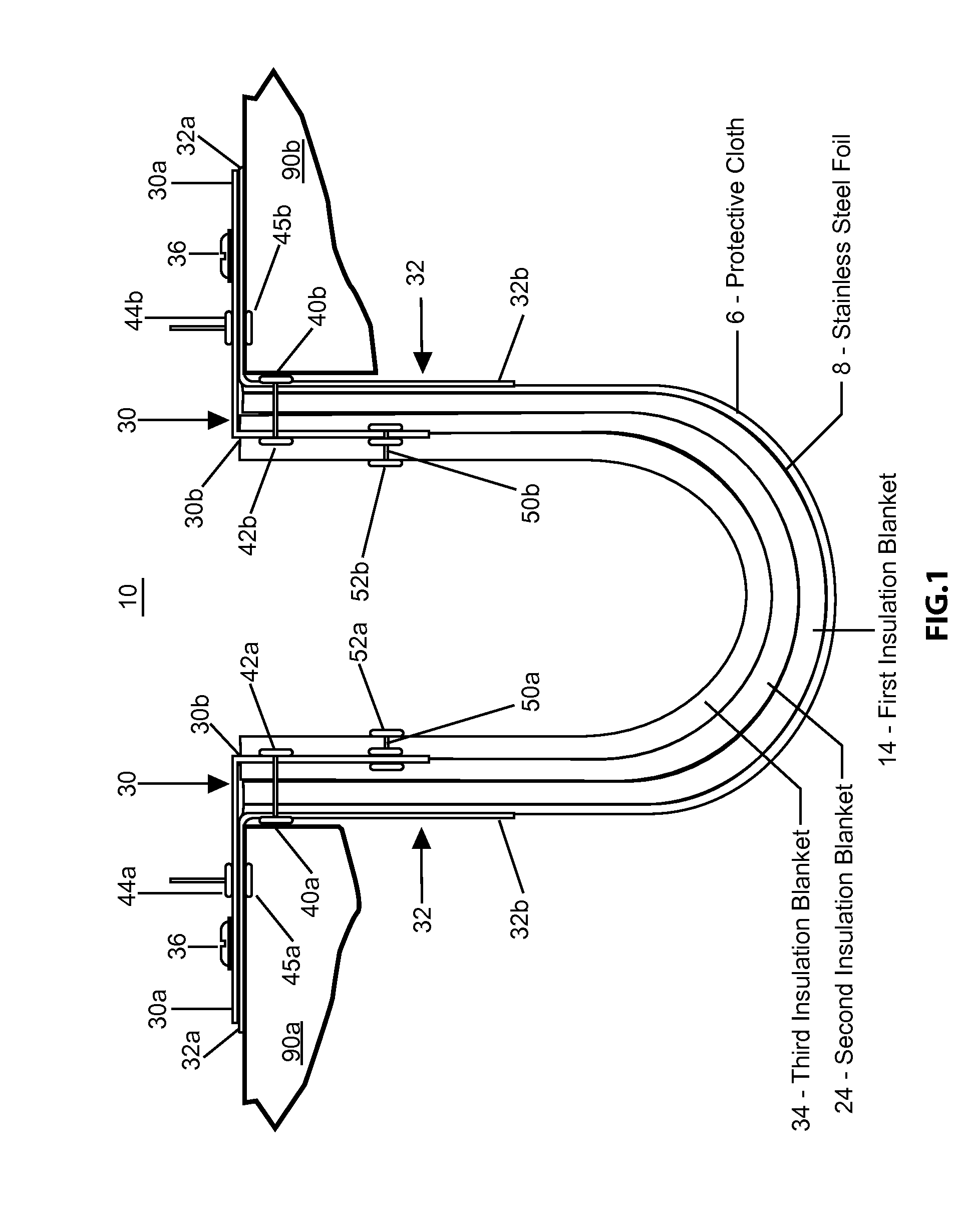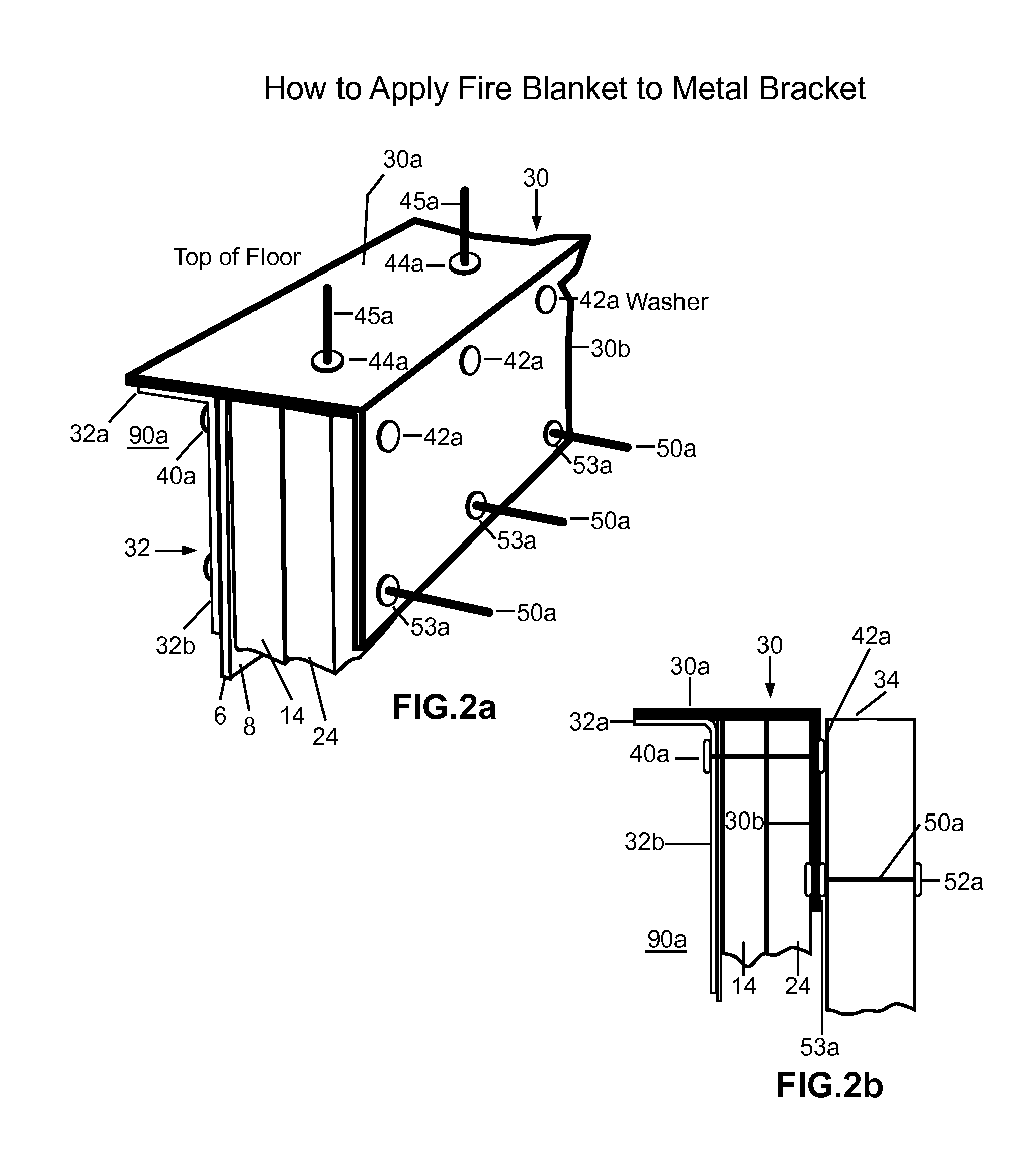[0010]The present Inventor recognized that the manufactured on-site barriers that were being used to fill the expansion-space-intersecting-spaces may likely not pass the cycle and fire tests. One problem with constructing barriers on-site is that they are constructed from parts of sectioned straight-line barriers. However, when any tested, rated, and certified fire-barrier is modified in any way, it immediately loses its certification and rating. To be able to use the on-site constructed barriers, builders must have their engineers certify the barriers. That does not mean, however, that these on-site constructions are capable of passing the extension / compression and fire-test, which could result in a building and its occupants being at a serious risk in the event of a fire. Moreover, in order to fit an especially long straight-line section several barriers or sections of barriers must be spliced together. The present inventor feared that spliced seams between sections of straight-line barriers and between straight-line barriers and expansion-space-intersecting fire-barriers could allow hot air,
smoke, toxic gases, and fire to travel throughout the expansion-joint-spaces of a building. Furthermore, as the connections formed during the requiring splicing procedures, are sometimes simply staples, and as spliced barriers have been known to be installed by non-specialists, they may not stand up to even relatively mild stresses of tension / compression and / or shear movements. Furthermore, the present Inventor realized that not only is on-site assemblage and splicing of fire-barriers inherently an unsafe practice, it is time-consuming and often the barriers so produced often require more than one installation person, which all adds significantly to the total construction cost. Moreover, he realized that on-site assembling could and likely did
expose workers hands and arms to being
cut by the thin sheets of stainless steel that are often a part of a fire-barrier, and that whenever the installers would
cut the
fiber glass (or similar material) blankets breathable sized fibers are introduced into the workplace
atmosphere resulting in increased worker's insurance. The present inventor recognized how beneficial to the worker, the contractor, and the building owner it would be to have fire-barriers, both those for fitting into straight-line expansion spaces and those for fitting into intersecting-expansion-spaces, pre-assembled with male and female coupling-ends that provide not only for one-step drop-in installation of all of the styles of barriers into their respective expansion spaces, but for self-coupling of each barrier to its adjacent barrier as part of the drop-in installation while avoiding any gaps such are seen in other barriers. Such an improved product would greatly reduce both the time it takes to install the barriers and the health risks, thus
cutting the cost of construction and worker's liability insurance.
[0011]Thus, the present Inventor recognized that without better fire-barriers, life and property would continue to be at
increased risk whenever there was a fire in a building mandated to have expansion-
joint spaces. He contemplated that to be able to have code-tested and rated geometrically complex intersection-space fitting fire-barriers, each barrier should be designed and constructed to have continuous-piece construction, and to have no openings or gaps through the barrier so as to prevent providing a pathway for the travel of
smoke, fire, or gases. The present inventor also believed that he could design ways to connect adjacent barriers to each other to avoid the gaps that exist in the designs currently used, so that an entire family of straight-line and expansion-space-intersecting fire-barriers could all be tested, rated, and certified by an approved testing agency.
[0013]The fire-barriers of the present invention are unique in several ways. One point of novelty is that both intersection-space and straight-line barriers are available as tested, rated, and certified pre-assembled barriers, all having female / male coupling-ends. One example, provided herein as a favored embodiment, is an L-shaped fire-barrier (also referred to as a horizontal / vertical barrier) having male / female connecting ends that can be installed in a one-step, drop-in process into a L-shaped intersecting-expansion-joint-space created by the convergence of the expansion spaces between two building structures, such as a floor and a wall or a wall and a ceiling. The L-shape, as illustrated, however, is only one of a large number of possible configurations that can be embodied with the principles of the present invention. The invention contemplates one-piece, male / female coupling-ended barriers shaped for fitting into cross-shaped, T-shaped, and L-shaped intersecting-expansion-spaces. It should be noted that L-shaped barriers may also be manufactured having additional horizontal / horizontal arms. All of the barriers manufactured according to the inventive principles described herein are available having female connections, male connections, or both, depending on the specific configuration of the intersecting-expansion-spaces. The interdigitating female / male coupling-ends taught herein require only a bead of fire-resistant caulk to be applied over the seams between the two coupled barriers. No
cutting or stapling, or other attachments are required by the overlapping coupling-ends. Once barriers are coupled there are no gaps in the coupled areas which is due to the fact that there is no extension of the outer protective cloth along its
long axis, so as to provide for the protective cloth to cover the insulation
blanket layers throughout the male / female interdigitating area. Not having such an extended length of protective cloth folded over the male or female shaped ends prevents the creation of a gap where the extended protective cloth is folded over the insulation
blanket layers and so must “bend” around the offset layer(s) of insulation blanket. In the barriers of the present invention, one layer of
refractory material is laid flat against its adjacent layer. Thus there are only flat layers adjacent to flat layers, that is, all layers are laid-flat, and there is no folding or pleating with a layer. Thus, there need be no holes punched into the insulation blankets and protective cloth to bring them close together and to attach them, and following, there are no holes through the totality of the overlapping sections in the coupled areas, as no wire or other attachment means goes through the overlapped areas so as to attach the overlapping female / male portions to each other. Additionally, each style of male and female ended fire-barrier is supplied with its own optional reusable installation tool that provides for even quicker, easier, and
safer one-step, drop-in installation of both the pre-assembled, female and male ended multi-directional / multi-dimensional and straight-line fire-barriers. The installation tools are not only reusable, but also easily and rapidly size-adjustable for use with differently sized versions of the same style barriers.
 Login to View More
Login to View More  Login to View More
Login to View More 


